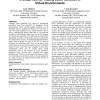Free Online Productivity Tools
i2Speak
i2Symbol
i2OCR
iTex2Img
iWeb2Print
iWeb2Shot
i2Type
iPdf2Split
iPdf2Merge
i2Bopomofo
i2Arabic
i2Style
i2Image
i2PDF
iLatex2Rtf
Sci2ools
AVI
2004
2004
A visual tool for tracing users' behavior in Virtual Environments
Although some guidelines (e.g., based on architectural principles) have been proposed for designing Virtual Environments (VEs), several usability problems can be identified only by studying the behavior of real users in VEs. This paper proposes a tool, called VU-Flow, that is able to automatically record usage data of VEs and then visualize it in formats that make it easy for the VE designer to visually detect peculiar users' behaviors and thus better understand the effects of her design choices. In particular, the visualizations concern: i) the detailed paths followed by single users or groups of users in the VE, ii) areas of maximum (or minimum) users' flow, iii) the parts of the environment more seen (or less seen) by users, iv) detailed replay of users visits. We show examples of how these visualizations allow one to visually detect useful information such as the interests of users, navigation problems, users' visiting style. Although this paper describes how VU-Flo...
| Added | 30 Oct 2010 |
| Updated | 30 Oct 2010 |
| Type | Conference |
| Year | 2004 |
| Where | AVI |
| Authors | Luca Chittaro, Lucio Ieronutti |
Comments (0)

